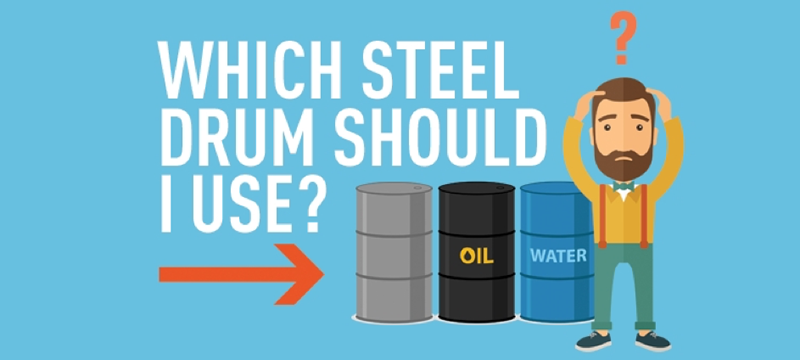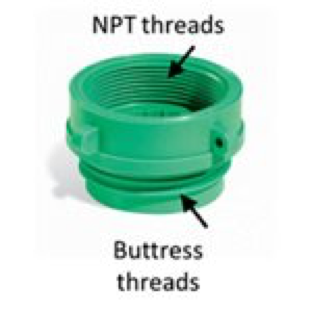|
【有问必答】头大了!我该用哪个钢桶?
文/三哥

许多工厂在生产过程中使用钢桶。它们的使用方式千差万别,就像它们所在的数千种制造工厂一样。一些最常见的用途是大量储存/运输化学品和收集废物(液体或固体)。它们接触的液体和化学品是多种多样的,它们的工作也会随着你的工厂需求而变化,所以需要不同种类的桶来配合你的应用。但是你怎么知道你需要哪一个呢?
1、制造材料
大多数桶是由碳钢或不锈钢制成的。不锈钢比碳钢有更好的耐化学性。因此,如果你的工厂使用腐蚀性的化学品,或者如果有广泛的液体可能接触到的桶,不锈钢桶将更多功能和处理更多的工作。钢桶也可以内衬以增加耐腐蚀性能。
2、钢板厚度
钢板的厚度很重要,这取决于你使用钢桶的原因。较厚的桶推荐用于运输危险液体,因为它们比薄的桶更坚固。此外,桶越厚,它能承受的重量和压力就越大。大多数钢桶在描述桶的厚度时都是这样的,1.5/1.2/1.2毫米,但这意味着什么呢?这显示了桶盖/桶体/桶底不同部位的厚度。在上面的例子中,这意味着盖子是1.5毫米厚,桶身是1.2毫米厚,桶底是1.2毫米厚。大多数钢桶的厚度在0.9 - 1.5毫米之间。
3、开口或者闭口
钢桶的封闭器可以是开口的(盖子可以拆卸),也可以是闭口的(盖子是永久固定的)。开口桶通常用于频繁添加或提取内容物的场合。开口桶使它更容易与固体和较浓的液体(土壤,吸收剂,糖浆,胶水,油等)工作,而闭口桶通常用于较低粘度的液体。

开口桶上的盖子通常与螺母和螺栓环连接,可以紧固到特定的扭矩,以满足联合国额定值的要求。您还可以使用快速打开的杠杆锁环,以方便打开和关闭,消除每次需要使用工具来拆卸盖子。New Pig开发了一种独特的锁盖系统,用户可以用一只手打开和关闭一个开口桶,无需工具。锁盖系统是最方便,最简单的方式打开钢桶。
4、桶塞的类型
如果您打算使用漏斗向桶中灌装液体,或者如果您打算用输液泵配件,以便将液体从桶中直接泵入某个工序,您需要知道盖子上的塞子(顶部开口)是什么类型的。一个闭口桶通常有两个塞子,一个直径为2英寸,一个直径为3 / 4英寸。塞子上的螺纹几乎总是NPT(国家管道锥度),但偶尔也可能是Buttress类型。NPT螺纹是细螺纹,而Buttress螺纹是粗螺纹。他们也有不同的结构风格,这可能需要一个专门的工具来拧紧。

与用于连接两根管道的直管螺纹不同,npt螺纹连接件将拉紧,以形成液体密封。大多数钢桶有npt螺纹塞子桶口和盖。支撑螺纹也设计用于形成液体密封,但比NPT螺纹更大、更粗。支撑螺纹也被称为“锯齿螺纹”,设计用于处理高应力,如收紧塞子开口的漏斗。典型地螺纹开口和桶盖是在塑料桶而不是钢桶上应用的。
WHICH STEEL DRUM SHOULD I USE ?
Many plants use steel drums in their processes. The way they are used is as varied as the thousands of types of manufacturing plants they are found in. Some of the most common uses are bulk storage/transport of chemicals and waste collection (liquid or solid). The liquids and chemicals they come in contact with are varied and the jobs they do change with your plant’s needs, so different kinds of drums are needed to match your application. But how do you know which one you need?
Construction Material
Most drums are made of either carbon steel or stainless steel. Stainless steel offers better chemical resistance than carbon steel. So, if your plant uses aggressive chemicals or if there is a wide range of liquids the drum may come in contact with, a stainless steel drum will be more versatile and handle more jobs. The drums can also be lined for added corrosion resistance.
Steel Thickness
The thickness of the metal is important depending on the reason you’re using a drum. Thicker drums are recommended for shipping hazardous liquids, as they’re stronger than thinner drums. Plus, the thicker the drum, the more weight and pressure it can handle. Most drums show something like this – 1.5/1.2/1.2 mm – when describing the thickness of the drum, but what does that mean? This shows the thickness of the different parts of the drum – lid/body/base. In the above example, that would mean that the lid is 1.5 mm thick, the body is 1.2 mm thick and the base is 1.2 mm thick. Most drums fall in the range of 0.9 – 1.5 mm thick.
Open or Closed Head
Drums are either open head (lid can be removed) or tight/closed head (lid is permanently secured). Open-head drums are typically used in situations where frequent addition or extraction of the contents occurs. Open-head drums make it easier to work with solids and thicker liquids (soils, absorbents, syrups, glues, oils, etc.) while tight-head drums are typically used with lower viscosity liquids.
The lid on an open-head drum is typically attached with a nut and bolt ring, which can be tightened to a particular torque to meet UN Rating requirements. You can also use quick-opening lever lock rings for easy access and closure, eliminating the need to use tools every time you want to remove the lid. New Pig has developed a unique latching lid system that enables users to open and close an open-head drum with one hand and no tools. The latching lid system is the most convenient, easiest way to access your drum.
Bung Threading:
If you intend to use funnels to add liquids to your drum, or if you intend to add pump fittings for pumping liquids out of your drum directly into one of your processes, you will need to know what type of bung (top opening) is on the lid. A tight/closed-head drum would typically have 2 bungs, one 2” and one ¾” in diameter. The threads on the bungs are almost always NPT (National Pipe Taper), but occasionally could be Buttress type instead. NPT threads are a fine thread and Buttress threads are a coarse thread. They also have different head styles, which may require a specialized tool for tightening.
Unlike straight pipe threading that is used to join two pieces of pipe together, NPT-threaded fittings will pull tight to make a liquid-tight seal. Most steel drums have NPT-threaded bung openings and caps. Buttress threads are also designed to form a liquid-tight seal, but are larger and coarser than NPT threads. Buttress threads are also known as “saw threads” and are designed to handle high stress, such as tightening a funnel into the bung opening. Typically, Buttress-threaded openings and caps are found on plastic drums rather than steel.
|

